How to choose the best fan for your home
Everyone knows what a household fan is: it, by increasing the air circulation, is able to improve the comfort conditions in the house. The cooler is also successfully used as an exhaust device. For example, a fan for a bathroom or a kitchen hood removes excess moisture and odors remarkably. In the living rooms, especially in the summer, the fans create the effect of the wind blowing, which makes a person a little cooler. How to choose the fan that suits you, we will tell in this article.
Content
Types of coolers
Thinking about how to choose a fan for the house, you should know that, by their design and purpose, the devices are divided into the following types:
- wall (exhaust);
- desktop;
- floor standing;
- channel;
- fan heaters.
Before choosing a fan, decide how you will use it. Coolers are selected for each room separately, taking into account their purpose.
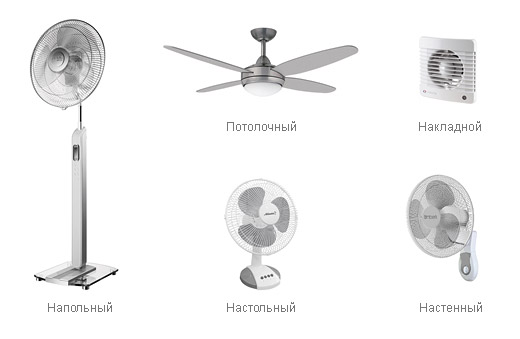
Wall (exhaust) devices
Wall mounted coolers exhaust air removalsaturated with moisture and various odors. The air is removed from the room either into the ventilation ducts or immediately out through the wall opening. Sometimes the exhaust cooler is installed in the window. But before you choose an exhaust fan in the bathroom and toilet, you should consider some of the nuances.
Bathroom hood
Many wonder if you need a fan in the bathroom? Answer it is definitely impossible. The need to install a cooler in the bathroom may arise if you notice the formation of black mold on the walls. The occurrence of a fungus can only mean one thing - in the room there is excessive humidity and poor air exchange.
To check the effectiveness of a natural extractor for a bath or toilet, attach a thin paper sheet to the grill covering the ventilation shaft, after opening the vent window in any room. If the sheet “sucked” to the lattice, it means that everything is in order with the bollard.Otherwise, you will have to study the question of how to choose a fan for the bathroom. Also, you can check the power of deflection of the flame from a match or lighter. With a good air flow, the flame will deflect almost at a right angle or go out. If the tongue of flame deviates slightly, it means that the draft is insufficient, and the room will create all the conditions for the development of mold on the walls, namely, increased humidity. Only installation of the fan for a bathroom can solve this problem.
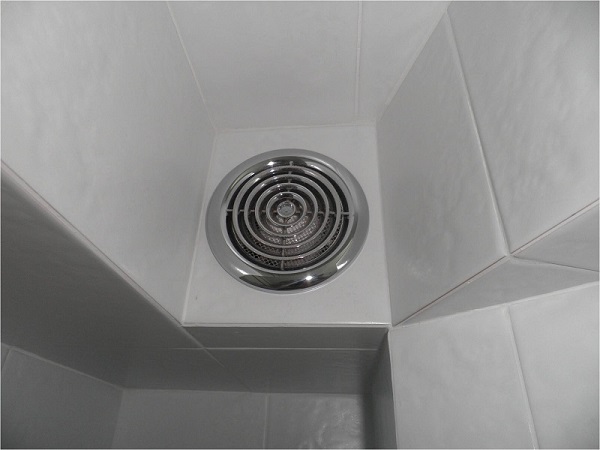
Choosing a fan in the bathroom, remember - it should be with moisture resistant. In addition, it is better if it will be installed humidity sensor. This design of the unit allows it to work offline, without human intervention. As soon as the humidity in the room reaches a certain value, the sensor is activated, and the hood is turned on. At achievement of normal indicators of humidity - the device is turned off.
It is worth knowing that a cooler with a moisture meter is a bit more expensive than a conventional device (without “bells and whistles”).
To save money, the choice of a fan for the bathroom can be stopped on a conventional exhaust cooler, which will have to be turned on and off manually.
Hood for toilet
Before you choose a fan for the toilet, you should know that for this room the model of the cooler has its own specifics. The toilet is a rather popular room among households. Therefore, on-off device in manual mode, according to reviews of people faced with this fact, it is very inconvenient. Often the product is connected to a light switch, and it works as long as the toilet is turned on.
To choose the right exhaust fan for the toilet, there are 2 solutions.
- Fan with built-in sleep timer. After turning off the lighting in the toilet, the unit continues its work for some time, pre-installed by you. When the time is up, the device will turn off.
- Fan in the toilet with integrated motion sensor and timer is an ideal option working autonomously. When a person enters the room, a motion sensor (volume) is triggered, and the unit is turned on. When a person leaves the toilet, the sensor seems to turn off the device, but a timer is activated, which after a certain period of time will work to turn off the device.
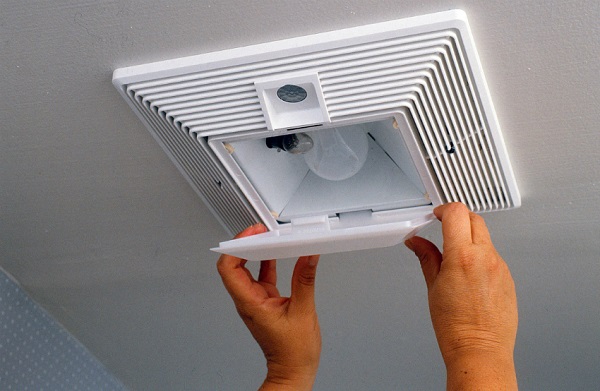
In addition to all the above, the fan in the toilet and bathroom should be installed taking into account such a parameter as power or performance, which is measured in m3/ h According to the standards established for the bathrooms, the air in them should change at least 8 times within 1 hour. Therefore, the number “8” is the air exchange coefficient when calculating the power of the unit.
To make calculations, you first need to calculate the volume of the room in which the unit will be installed. To find the volume for the bathroom and toilet, measure their height, width and length, and then multiply these values together.
The formula for calculating the power (performance) of the cooler is as follows: volume of the room * 8 (air exchange rate).
For example, the volume of the bathroom is equal to 16.8 m3. From this it follows that the performance of bathroom fans should be: 16.8 * 8 = 134.4 m3/ h It is recommended to buy a cooler with a small margin of performance. In this case, the device with indicators of 150-200 m3 / h will be great to cope with its task. The performance of the exhaust fan for the kitchen is calculated by the same formula, only the rate of air exchange will be equal to 10 or 12.
It is also important to buy a cooler, for example, for the bathroom, with integrated check valve. It will be useful if you install the unit in common with the kitchen and toilet ventilation path. The valve will not allow the exhausted air from the other rooms to enter the bathroom. A check valve is still needed if the hood is mounted in a window or in a hole in the wall leading to the outside.

Desktop and floor coolers
The key characteristics of fans of various designs designed for residential premises are universal.
- Blade size and diameter of the propeller. The more these indicators, the more powerful will be the air flow generated by the device, and the faster the cooling of the room will occur. In the literal sense, the cooler will not cool the room - only air conditioning can do this. The cooler is only able to cool our body with a stream of air, which is why the illusion of coolness is created.
- Safety net. It must be installed on the product, whether it is a table fan or an outdoor version of it. The mesh will protect you from being hit by a screw, painful enough if you accidentally hit the machine with your hand. Also, without protection can not do if the house has small children and pets.

- Machine power. The higher it is, the more effective the air exchange in the room will be, and the stronger the flow of air masses. The standard power of the coolers is in the range from 40 to 60 W, and this is enough for apartment conditions. But for a room with a large area it is better to choose a unit with maximum power values.
- Noise level. Before you pick up the fan, you should consider the fact that the smaller the power of the product, the more noiseless it is. Therefore, for recreation areas, it is necessary to focus on the choice of a low-noise version of the cooler, not exceeding 30 dB. For example, for a bedroom and a children's room, the noise level should not be higher than 25-28 dB.
- Resilience. This rule applies especially to the floor fan. When choosing a cooler, carefully study the unit stand - is it reliable enough? It is important if the product has the possibility of height adjustment.

- Turns. Virtually any cooler, floor or tabletop, has a function that allows the propeller to rotate in different directions. Due to this, the air flow moves in different directions and reaches all parts of the room.
- Control system. Modern fans, in addition to several modes (speeds) of work, are equipped with timers, air ionizers, and remote control modules. Do not skimp to choose a good unit. After all, the presence of additional functions greatly facilitates the operation of the product.
- Availability of warranty. Ventilation equipment, like any household appliances, should have a warranty period of at least 1 year. Do not buy the product without warranty, or if it is 1 month.
Ducts
How to choose an exhaust fan at once for all rooms, if you live, for example, in a private house? In this case, you should opt for a duct fan.

Its key difference from the wall cooler is that it can be embedded inside the ventilation duct.

Embedded technology allows you to implement the hood in several rooms at once.
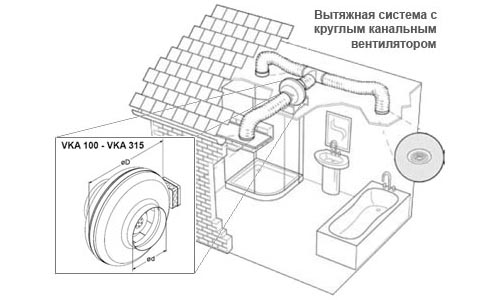
The choice of exhaust fan (duct) is made taking into account its performance for wall mounted units, as described in detail above. In addition, the built-in hood must be quiet.
Fan heaters
If during the cold season the heating of your home does not cope with its functions,or it is not yet included, as in the case of centralized heating in a city apartment, it is worth considering how to choose a fan heater for heating a home.

Electric heat cooler, as a rule, is a floor option, and differs from its fellow built-in heating element. Therefore, the main criteria in the question of which fan to buy will be its power, type of blades and heating element.
A heating element
Heaters with an open spiral are inexpensive devices. The air in these devices is heated by passing through the hot nichrome spiral. During operation, the wire of nichrome can heat up to a temperature of almost a thousand degrees.

Despite the high performance of units with an open spiral, they have the following disadvantages.
- An open spiral is nothing but a conductor with alternating current flowing through it. Since the conductor is not insulated, the child may insert a metallic object, such as a paper clip, through the protective grid, and get an electric shock.
- maybe fire of various objects. For example, a fluff, paper, or a dustball may fall on the spiral.
- Short life heating element because it is in direct contact with air.
Devices with ceramic heaters are considered the most perfect.. Therefore, making the selection of a fan for heating should take into account this point. Units with ceramics even differ in their appearance. Through the grille you can see something like a radiator.
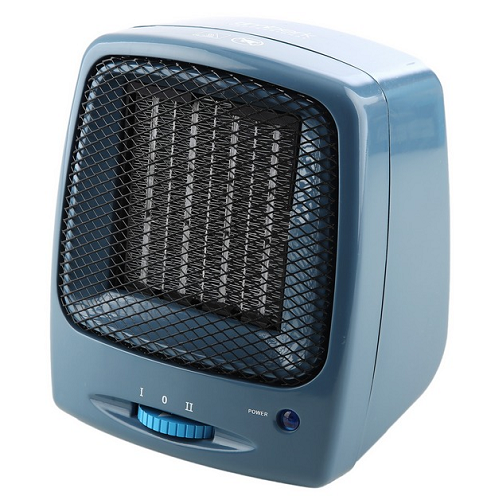
The figure below shows what ceramic heaters for a heated cooler look like.

These elements do not heat above 150°C, considered the safest and most economical in operation. The only drawback of coolers with ceramics is their cost, which is significantly different from the price of thermal coolers with an open spiral.
Blade type
Axial coolers are the most common. The device they have is quite simple: on the axis of the electric motor there is a propeller, the blades of which are turned at a certain angle (angle of attack). Rotating, the propeller creates a stream of air that coincides in direction with the axis of the electric drive.
When choosing a unit, give preference to a model that has blades made of metal, since they are more durable and long-lasting.
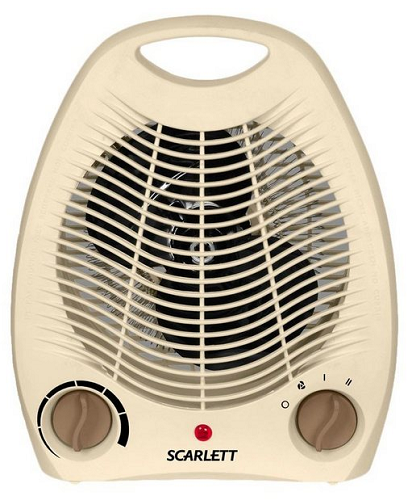
Despite the fact that the design of the device is very simple, it has one drawback - increased noise. Fan heaters having radial impeller (see picture below).

The air moves in such a product due to centrifugal force. The intake takes place in the upper part of the apparatus, and the air goes out perpendicular to the impeller cylinder. This design is efficient and, due to the quiet running of the impeller wheel, low noise.
If the noise for you is an annoying element, then select a product with a radial impeller.
Power
If a compact heat cooler will be used to easily heat the room or to supplement the main heating, the power of the heating element of 1-1.5 kW will be enough. But, if you want to use this type of unit as a replacement for the main heating, for example, in the country, then in this case buy a more powerful model (see figure below).

The figure shows the unit having tubular heating elements (TENY) thanks to which the necessary air temperature is maintained. Such devices are used mainly for household needs, for example, for heating greenhouses, etc.

/rating_off.png)











